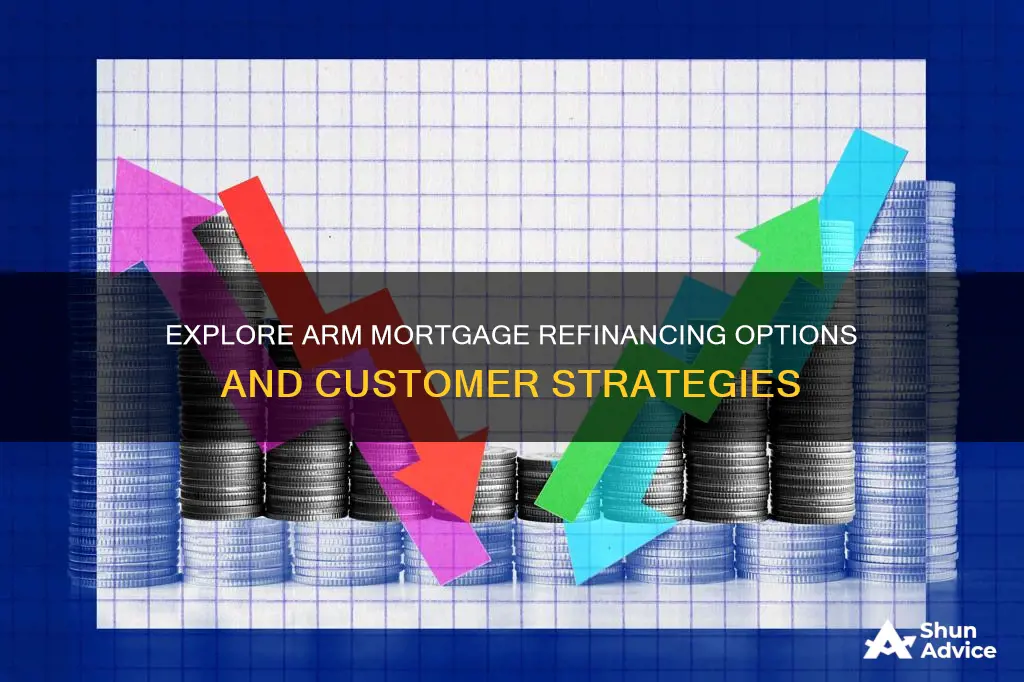
Adjustable-rate mortgages (ARMs) are a type of home loan with an interest rate that changes once the adjustment period begins. Typically, ARMs have a fixed-rate period at the beginning of the loan, lasting between 3 and 10 years, after which the rate adjusts based on market trends and index rates. This can result in significantly higher payments. As a result, many customers with ARM mortgages are choosing to refinance to fixed-rate mortgages, which offer more predictability and stability. However, refinancing comes with its own costs and potential drawbacks, and it may not always be the right choice for everyone.
| Characteristics | Values |
|---|---|
| Refinancing from ARM to fixed-rate mortgage | Possible at any time |
| Main benefits | Predictable payments, stable sum, budgeting ease, peace of mind |
| Main drawbacks | Closing costs, potential for higher long-term costs |
| Requirements | Credit score of 620 or higher for a conventional loan, 580 or higher for an FHA or VA refinance loan, debt-to-income ratio under 50% |
| Cost of refinancing | 2% to 6% of the loan amount |
What You'll Learn

Customers can refinance ARM mortgages to fixed-rate mortgages
Customers with an adjustable-rate mortgage (ARM) can refinance their mortgage into a fixed-rate mortgage. An ARM is a type of home loan with an interest rate that changes once the adjustment period begins. Typically, an ARM has a fixed-rate period for the first 3, 5, 7, or 10 years, after which the rate adjusts every 6 months or annually based on a market index. On the other hand, fixed-rate mortgages keep the same mortgage rate throughout the loan term, usually 15 or 30 years.
There are several benefits to refinancing an ARM into a fixed-rate mortgage. Firstly, fixed-rate mortgages offer predictable payments and interest rates that remain constant throughout the loan term. This can make budgeting easier and provide peace of mind, especially if you're expecting an interest rate adjustment on your ARM in the next year or two. Secondly, if you're nearing the end of your ARM's initial fixed-rate period and your rate is expected to rise significantly, refinancing to a fixed-rate mortgage can help you secure a lower interest rate and potentially save money in the long run.
However, it's important to consider the potential drawbacks of refinancing. Refinancing an ARM to a fixed-rate mortgage typically involves paying closing costs, which can range from 2% to 5% of your mortgage principal. While these costs are generally lower than the closing costs on a home purchase loan, they can still amount to thousands of dollars. Additionally, refinancing may not always be the right choice if you're comfortable with the risk of potentially higher payments after the fixed-rate period of your ARM ends and there is a possibility of the benchmark index dropping, resulting in a lower interest rate.
When considering refinancing, it's recommended to compare offers from multiple lenders and choose the one that best suits your financial goals and requirements. You can also use tools like the Rocket Mortgage Refinance Calculator to assess whether refinancing your ARM is a financially prudent decision. Additionally, ensure that you meet the general requirements for refinancing, such as a credit score of at least 620 and a debt-to-income (DTI) ratio of 50% or lower.
Understanding APR: The Mortgage Interest Rate Factor
You may want to see also

ARM refinance is ideal for specific financial goals
Budget Stability and Predictable Payments:
ARM loans have a variable interest rate that adjusts periodically, usually every six months or annually, based on market indices. This variability can make long-term financial planning challenging. By switching to a fixed-rate mortgage, borrowers can lock in a consistent interest rate for the entire loan term, making it easier to budget and plan for the future without worrying about potential rate hikes.
Avoiding Higher Payments:
ARM loans typically offer lower interest rates during an introductory fixed-rate period, usually lasting 3 to 10 years. However, once this period ends, the interest rate can increase significantly. If borrowers anticipate an adjustment in the upcoming years, refinancing to a fixed-rate mortgage can help them avoid these higher payments and provide long-term stability.
Long-Term Ownership:
If you plan to own the home for an extended period, a fixed-rate mortgage may be preferable. With an ARM, there is a risk of higher payments in the long run if the interest rates increase. By refinancing into a fixed-rate mortgage, you can secure a consistent rate and payment amount for the duration of the loan, regardless of market fluctuations.
Lower Interest Rates:
Market conditions play a crucial role in the decision to refinance. When interest rates are low, the gap between ARM and fixed-rate mortgages narrows. In such scenarios, refinancing into a fixed-rate mortgage can help borrowers secure a lower interest rate, reducing their overall mortgage expenses.
Simplified Finances:
ARM loans can be more complex than fixed-rate mortgages due to their variable nature. Refinancing into a fixed-rate mortgage simplifies finances, providing a single, stable interest rate and payment amount for the loan's duration. This simplicity can be particularly appealing to borrowers who value predictability and ease of management in their financial affairs.
When considering an ARM refinance, it is essential to evaluate closing costs, loan requirements, and the potential impact on long-term financial goals. Consulting with a financial advisor or mortgage lender can help individuals make informed decisions that align with their specific financial objectives.
Understanding Allowances: Mortgage Calculations Explained
You may want to see also

ARM refinance provides stable monthly payments
Refinancing an adjustable-rate mortgage (ARM) into a fixed-rate mortgage can provide customers with more stable and predictable monthly payments. While ARMs typically offer a lower, fixed interest rate for an introductory period, this rate becomes adjustable and fluctuates based on market trends once the initial period ends. This can lead to significant changes in monthly payments, making budgeting a challenge.
On the other hand, fixed-rate mortgages keep the same mortgage rate throughout the loan term, providing certainty and predictability. By refinancing an ARM into a fixed-rate mortgage, customers can lock in an interest rate and simplify their monthly payments. This option is particularly appealing to those expecting an adjustment in their ARM interest rate in the near future.
The process of refinancing an ARM into a fixed-rate mortgage is relatively straightforward and similar to the initial home purchase process. However, it is important to consider the potential costs and benefits. Refinancing is not free, and customers will need to budget for expenses such as closing costs, origination fees, appraisal fees, and title services. These costs can range from 2% to 5% of the loan amount.
Additionally, customers should evaluate their financial goals and consider the current interest rate trends. Refinancing may not always result in a lower interest rate, especially if their credit score has decreased since obtaining the original ARM mortgage. Extending the loan term through refinancing can also lead to paying more in interest over time, despite potentially lower monthly payments.
Overall, refinancing an ARM into a fixed-rate mortgage can provide customers with stable monthly payments and protect them from fluctuating interest rates. However, it is important to carefully consider the potential costs and benefits before making a decision.
Mortgage Prequalification: Is It Reliable?
You may want to see also

ARM refinance may increase costs if interest rates rise
Adjustable-rate mortgages (ARMs) are a type of home loan with an interest rate that changes once the adjustment period begins. Typically, an ARM starts with a low, fixed interest rate for an introductory period of 3 to 10 years. After this period, the interest rate adjusts every 6 months or once per year, based on a specific market index. This can result in a significant increase in monthly mortgage payments, which may impact a borrower's financial goals and budget.
When interest rates rise, ARM borrowers may face higher monthly payments, making refinancing to a fixed-rate mortgage an appealing option. Refinancing involves replacing the existing ARM with a new, fixed-rate loan, providing predictable and stable payments over the loan term. However, refinancing comes with closing costs, typically ranging from 2% to 5% of the loan amount, which can be rolled into the loan but will accrue interest.
While refinancing an ARM to a fixed-rate mortgage offers the advantage of stable payments, it is essential to consider the potential costs. In addition to closing costs, borrowers may encounter other expenses such as origination fees, appraisal fees, and title services. These costs can reduce or delay the financial benefits of refinancing. Therefore, it is crucial for borrowers to assess their financial goals and compare interest rate trends before making a decision.
Moreover, refinancing an ARM may not always be the right choice. If interest rates are declining, borrowers may benefit from sticking with their ARM, as they can take advantage of the initially lower rates. Additionally, refinancing may not be feasible for borrowers with a high debt-to-income ratio, as lenders prefer a lower ratio to ensure the borrower is not financially stretched too thin.
To make an informed decision, borrowers should review their finances, loan agreements, and interest rate trends. By understanding the potential costs, eligibility requirements, and the protections offered by different types of caps on rate increases, borrowers can determine if refinancing their ARM aligns with their financial goals and budget constraints.
Mortgage Advising: After the Loss of a Spouse
You may want to see also

ARM refinance requires closing costs
Refinancing an ARM loan into a fixed-rate mortgage is a common choice for homeowners. This is because fixed-rate mortgages offer a consistent monthly payment, making it easier to budget. However, refinancing isn't free, and closing costs can be significant.
Closing costs for refinancing an ARM loan can range from 2% to 5% of the mortgage principal. For example, on a $300,000 mortgage, closing costs could be between $6,000 and $15,000. These costs can include origination fees, appraisal fees, and title services. While refinancing costs are generally lower than closing costs on a home purchase loan, they can still impact the benefits of refinancing.
There are a few options for paying closing costs. One option is to pay them upfront at the time of closing. Alternatively, borrowers can choose to roll the closing costs into the loan, but this means paying interest on those costs over time. Some lenders may also offer a no-closing-cost refinance option, but it's important to understand that the costs are likely built into the loan in other ways, such as a higher interest rate.
Before deciding to refinance an ARM loan, it's essential to consider the potential benefits and drawbacks. Refinancing to a fixed-rate mortgage can provide stability and predictability in monthly payments, which is especially attractive when interest rates are expected to rise. However, fixed-rate mortgages typically have higher interest rates than adjustable-rate mortgages, so the stable payment could be higher than an adjusted payment. It's also important to evaluate the length of the new fixed-rate loan, as refinancing may extend the repayment period.
In conclusion, while refinancing an ARM loan into a fixed-rate mortgage can offer stability and predictability, it's important to carefully consider the closing costs and potential benefits and drawbacks before making a decision.
Zillow's Mortgage Estimates: Accurate or Misleading?
You may want to see also
Frequently asked questions
ARM stands for adjustable-rate mortgage. This type of mortgage has a short fixed-rate period, typically lasting between 3 and 10 years, before switching to a variable rate. This variable rate can change every 6 or 12 months.
Refinancing an ARM mortgage to a fixed-rate mortgage can provide more stability and make budgeting easier. With a fixed-rate mortgage, your interest rate remains the same for the life of the loan, whereas with an ARM mortgage, your interest rate can increase significantly after the introductory period.
The best time to refinance is when mortgage rates are low. This will help secure lower payments for a longer term. It is also a good idea to refinance before the fixed-rate period on your ARM mortgage ends, to avoid the risk of higher payments later.
To refinance your ARM mortgage, you will need to meet your lender's requirements, which can vary, but often include having a credit score of 620 or higher. You will also need to pay closing costs, which can amount to between 2% and 6% of the loan amount.







